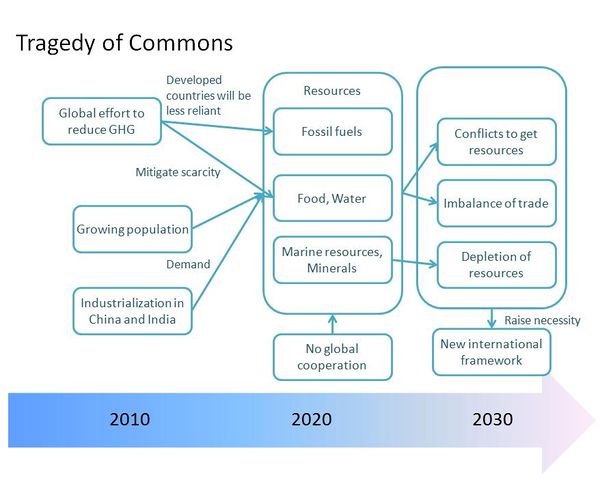Tragedy of Commons
Summary
Due to the global cooperation regarding green house gas emissions, rapid global warming was avoided. However, growing population and industrialization made resource issues more serious. Since there were a variety of resources on which each country had different interests, global leaders struggled with making international regulations in order to consume them sustainably. By the 2020s, some natural resources started to deplete, and countries stockpiled their resources locally. Increases in resource prices affected all product prices, and least developing countries could not follow this movement. Thus, countries reserving natural resources have prospered on one hand, and the gap between rich and poor countries has widened on the other hand.
Description
2010
World leaders including China, Russia, and India started working on reducing greenhouse gas emissions in order to mitigate climate change in 2010. The Copenhagen Protocol of December 2009 and following meetings were successful in deciding new targets of green house gass (GHG) reduction and methods to achieve this target. Adoption of reduction rules was universal by 2013. These rules imposed limits of GHG emissions throughout manufacturing processes on companies and adopted financial incentives to popularize green technologies such as electric vehicles and renewable energies. Although people still made purchase decisions based on the price of products, they increased the consumption of eco-friendly products because local regulations barred cheap eco-unfriendly products from markets and financial incentives compensated the price gap. According to the Intergovernmental Panel on Climate Change, it was expected in 2010 that the temparature would increase by approximately 0.2 degree Celsius for every decades by 2030. Global cooperation succeeded in getting the earth on the track of normal climate cycle. However, our active consumption brought up another problem, scarcity of resources.
2020
The world population reached 7.9 billion 117% compared with the level in 2010. China and India become one of the wealthier countries in the world and industrialization in these countries accelerated global consumption of resources. Because of the process of industrialization, food self-sufficiency rates declined and the composition of global trade changed. Reserves of nonrenewable resources such as oil and metals declined rapidly and consumption of renewable resources exceeded the speed of reproduction. Depletion of resources became a more serious problem than before, and their price soared. Although prevention of global warming and technological development contributed to increased supply of resources, demand increased further. Countries which had natural resources came to have stronger political power. Developed countries, which relied on import of resources, enhanced the recycling of metals and utilization of bio-fuels. High material prices continued to undermine developed nations industries. Increasing price of commodities fatally hit the economy in least developed countries which could not secure natural resources domestically. These problems raised the necessity of discussion by global leaders focused on usage of natural resources.
2030
Although everyone recognized the high possibility of depletion and following effects, global leaders could not reach an agreement easily. Taking the example of tuna fishing in the Mediterranean, some countries, which were making a business out of fishery, disagreed with volume control. Interests were different for each country and resource, and regulations had to take into account this issue. Negotiations gradually showed positive results, but the delay of the decision made the problem worse. Some of resources had almost depleted when new regulations were finally adopted.
Under this situation, leaders became more sensitive with keeping resources in their countries, and imposed local regulations. For example, some countries decided to limit fishing and cracked down on illegal fishery. Seizer of fishing boats, which were illegally operating over the border, increased the tension among countries. Some countries made a dam which prevented countries in downstream from pulling water, and caused new conflicts. Rebellions caused by high food prices emerged in poorly developed countries. World experienced some terrible conflicts due to resource problems by 2030, and global leaders started to reach agreement in order to avoid further conflicts.
Common characteristics
- Lifestyle and Business
People were still consuming at high rates. Eco-friendly products became more popular due to governments’ incentive and regulations.
- Cooperation
The agreement in terms of new GHG emission target and relating regulations was great achievement. However, negotiation among countries gradually became more and more complicated. Unlike in the past, international negotiations had to involve countries which were not the member of G7. Leaders still advocated their opinion considering their own countries’ benefit. Thus some key international negotiations about natural resource collapsed.
- Environment
Due to the global cooperation, we avoided 2 degrees Celsius of global warming which was expected in 2010. This stopped desertification and deforestation as well. However, growing population and industrialization accelerated global consumption of resources. Actually, several natural resources has almost depleted.
Key Uncertainty
A key uncertainty is the level of cooperation governments will have. Traditionally countries seek self interest and national goals. If nations can see the benefit of working together then the ability to establish international frameworks on sustainability are possible.
